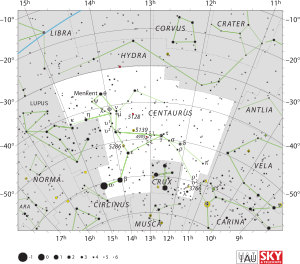HD 124448 (V821 Centauri) は、太陽系 から見てケンタウルス座 の方向約5,200光年 の距離にある10等星 の恒星 。スペクトル 中に水素 の吸収線スペクトル がほとんど見られず、強いヘリウムの吸収線が見られる「極端ヘリウム星 」に分類され、このタイプの恒星としては史上初めて発見されたものである。変光星 としてはぼうえんきょう座PV型変光星 に分類される脈動変光星 である[ 3]
1942年、アメリカ テキサス州 オースティン にあるマクドナルド天文台 でHD 124448を分光観測したアメリカの天体物理学者ダニエル・M・ポッパー (英語版 ) [ 7] [ 8] 水素 の輝線 も吸収線 も存在せず、鋭く強いHe I の吸収線と、O II とC II の吸収線が存在していた[ 7] [ 8] ぼうえんきょう座PV星 (HD 168476) が発見されると、HD 124448は発見者の名前を取って Popper's star とも呼ばれるようになった[ 2]
HD 124448のような極端ヘリウム星は、単独の恒星として進化したのではなく、既に恒星の段階を終えた炭素-酸素白色矮星とヘリウム白色矮星が合体し、再びヘリウム核融合 が始まったものと考えられている[ 4] [ 9]
^ a b パーセクは1 ÷ 年周視差(秒)より計算、光年は1÷年周視差(秒)×3.2615638より計算
^ 視等級 + 5 + 5×log(年周視差(秒))より計算。小数第1位まで表記
^ a b c d e f “V* V821 Cen -- Pulsating variable Star ”. SIMBAD Astronomical DatabaseCDS . 2021年12月29日 閲覧。
^ a b “H.D. 168476 and 124448 - two similar stars”. The Observatory 72 : 248-249. (1952). Bibcode : 1952Obs....72..248T . ISSN 0029-7704 .
^ a b c Samus’, N. N.; Kazarovets, E. V.; Durlevich, O. V.; Kireeva, N. N.; Pastukhova, E. N. (2017). “General catalogue of variable stars: Version GCVS 5.1” . Astronomy Reports 61 (1): 80-88. Bibcode : 2017ARep...61...80S . doi :10.1134/S1063772917010085 . ISSN 1063-7729 . https://vizier.cds.unistra.fr/viz-bin/VizieR-5?-ref=VIZ620265d01631d7&-out.add=.&-source=B/gcvs/gcvs_cat&recno=12147 .
^ a b Pandey, Gajendra et al. (2006). “An Analysis of Ultraviolet Spectra of Extreme Helium Stars and New Clues to Their Origins”. The Astrophysical Journal 638 (1): 454-471. arXiv :astro-ph/0510161 . Bibcode : 2006ApJ...638..454P . doi :10.1086/498674 . ISSN 0004-637X .
^ a b c d e f g h Gaia Collaboration. “Gaia data early release 3 (Gaia EDR3)” . VizieR On-line Data Catalog: I/350 . Bibcode : 2020yCat.1350....0G . https://vizier.cfa.harvard.edu/viz-bin/VizieR-5?-ref=VIZ620266a29bb9&-out.add=.&-source=I/350/gaiaedr3&-c=213.74424649825%20-46.28869302596,eq=ICRS,rs=2&-out.orig=o .
^ a b Hill, P. W. (1965-02-01). “The Spectra of Helium Stars, II: An Abundance Analysis of Three Helium Stars”. Monthly Notices of the Royal Astronomical Society (Oxford University Press (OUP)) 129 (2): 137–158. Bibcode : 1965MNRAS.129..137H . doi :10.1093/mnras/129.2.137 . ISSN 0035-8711 .
^ a b Popper, Daniel M. (1942). “A Peculiar B-Type Spectrum”. Publications of the Astronomical Society of the Pacific (IOP Publishing) 54 : 160. Bibcode : 1942PASP...54..160P . doi :10.1086/125431 . ISSN 0004-6280 .
^ a b “A Peculiar B-Type Spectrum”. Publications of the Astronomical Society of the Pacific (IOP Publishing) 54 : 161. (1942). Bibcode : 1942PASP...54..161. . doi :10.1086/125433 . ISSN 0004-6280 .
^ Saio, Hideyuki ; Jeffery, C. Simon (2002). “Merged binary white dwarf evolution: rapidly accreting carbon-oxygen white dwarfs and the progeny of extreme helium stars”. Monthly Notices of the Royal Astronomical Society 333 (1): 121-132. Bibcode : 2002MNRAS.333..121S . doi :10.1046/j.1365-8711.2002.05384.x . ISSN 0035-8711 .
